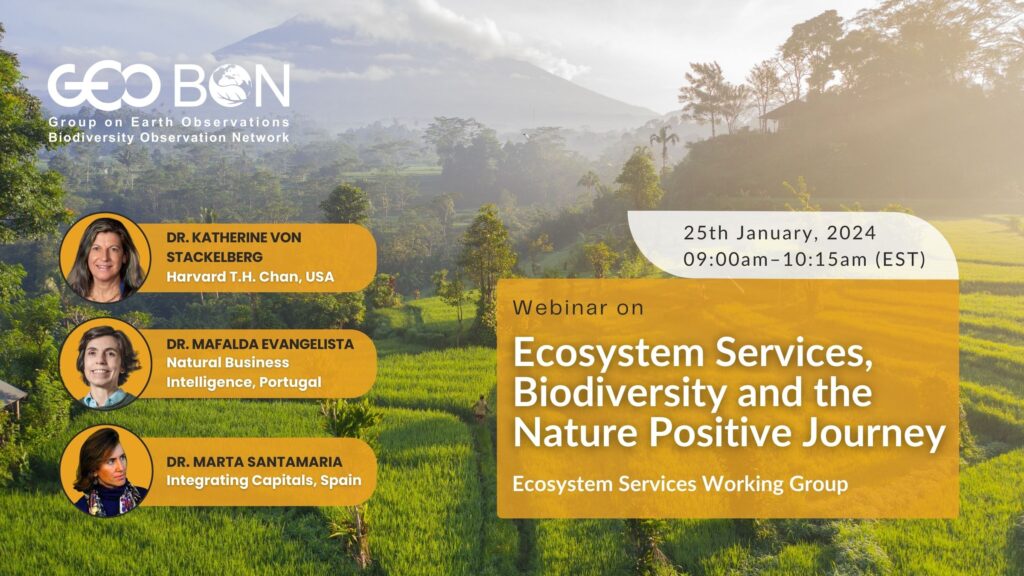
Recording available.
When: JANUARY 25th 2024
Time: 09:00 to 10:15 AM EST (03:00 to 04:14 PM CET)
Nature is the basis of the functioning of society, general well-being, and the economy. However, despite warnings from the scientific community for several decades, the degradation of nature is accelerating due to the impact of human activities. This is causing a decline in the services provided by natural ecosystems and consequently generating disruptions in supply chains, business operations and investments. Our reliance on nature to drive the economy is not new, but the concept of building a NATURE POSITIVE ECONOMY is rapidly gaining traction as we begin to understand our nature-related dependencies and impacts. “Nature positive” goes beyond our previous conviction of “be neutral” and “do no harm”, to leveraging the full economic performance gained from delivering goals based on themes such as biodiversity restoration and climate change resilience, to achieve a respectful, fair, and prosperous future for all. This webinar will present the “nature positive” paradigm at the interface between how we perceive, study, acknowledge and manage natural capital and ecosystem services, expanding on the opportunities for more sustainable livelihoods, economics, and socio-ecological systems. The webinar is organized by the Ecosystem Services Working Group with support from the GEO BON Secretariat.
Agenda
| Time (EST) | Item |
|---|---|
| 9:00 | Welcome, by Ana Sofia Vaz |
| 9:05 | Katherine von Stackelberg |
| 9:15 | Mafalda Evangelista |
| 9:25 | Marta Santamaria |
| 9:35 | Discussion |
| 9:45 | Q&A |
| 10:00 | Wrap-up |
Speakers
Dr. Katherine von Stackelberg – NEK Associates LTD and Harvard T.H. Chan School of Public Health, USA

Expert in developing tools and methods to support sustainable approaches to environmental decision-making, particularly with respect to ecosystem services, risk-based analyses, spatially-explicit bioaccumulation modeling, and quantitative approaches to uncertainty analysis. Most of Katherine’s projects focus on the intersection between science and policy: how do we define and evaluate the policy alternatives arising out of our understanding of the science. Katherine has received an A.B. cum laude from Harvard College, and a Sc.M. and Sc.D. from the Harvard School of Public Health in Environmental Science and Risk Management. She serves as Chair of the US EPA Board of Scientific Counselors and is also a member of the Scientific Advisors on Risk Assessment for the European Commission in Brussels. She’s currently affiliated to NEK Associates LTD and Harvard T.H. Chan School of Public Health, USA).
Dr. Mafalda Evangelista – Natural Business Intelligence, Portugal

Wide institutional representation activities at national and European level stakeholders and at events, and accompanied the development of legal, strategic and programmatic initiatives in the area of
corporate sustainability (climate change, biodiversity, circular economy, sustainable finance, reporting of non-financial information, etc.). Mafalda was responsible for the coordination of the act4nature Portugal initiative, for the development of the Business Council for Sustainable Development (BCSD) Portugal 2030 Journey. She is currently the natural capital director at NBI – Natural Business Intellgence, being responsible for the coordination and development of strategic management projects and valorization of natural capital, including on natural capital credit mechanisms, Nature Positive strategies for companies in different sectors of activity, as well as by projects integrating biodiversity and ecosystem services in ESG (Environment, Social and Governance) strategies.
Dr. Marta Santamaria – Integrating Capitals, Spain

Over 20+ years of experience in assessing the value provided by nature, people, and society to inform and transform decision making. Marta has worked extensively in the transformation of several economic sectors, including the energy, food, built environment and finance sector. Previously, she was Senior Director at the Capitals Coalition, where she was leading and advancing approaches to measure and value impacts and dependencies on nature, people and society. She has been advising several leading organizations, including the Taskforce on Nature-related financial Disclosures (TNFD), Science-based Targets Network (SBTN), Food and Agriculture Organization of the United Nations (FAO), the Impact Management Platform (IMP), the G7 Impact Taskforce, the International Organization for Standardization (ISO) and the Value Accounting Network (VAN).
Hosts

Ana Sofia Vaz
Natural Business Intelligence
Portugal

Nuria Pistón
University of Granada
Spain

Agnes Vari
McGill University
Canada

Flavio Affinito
McGill University
Canada
